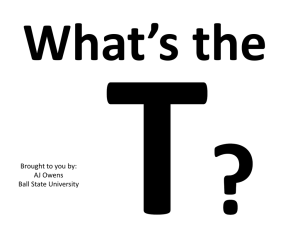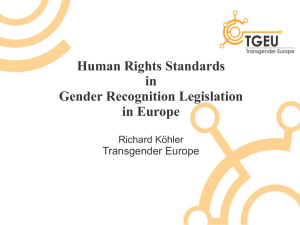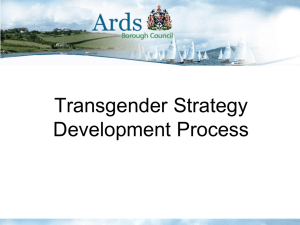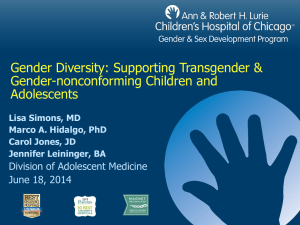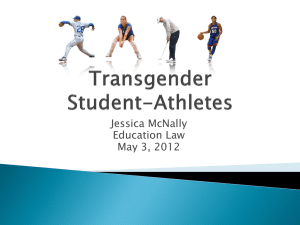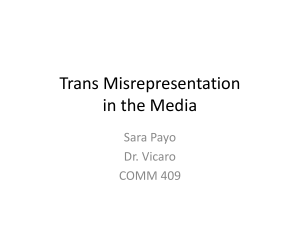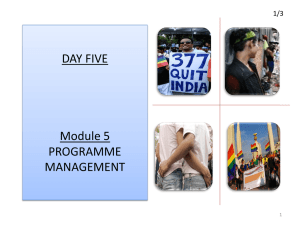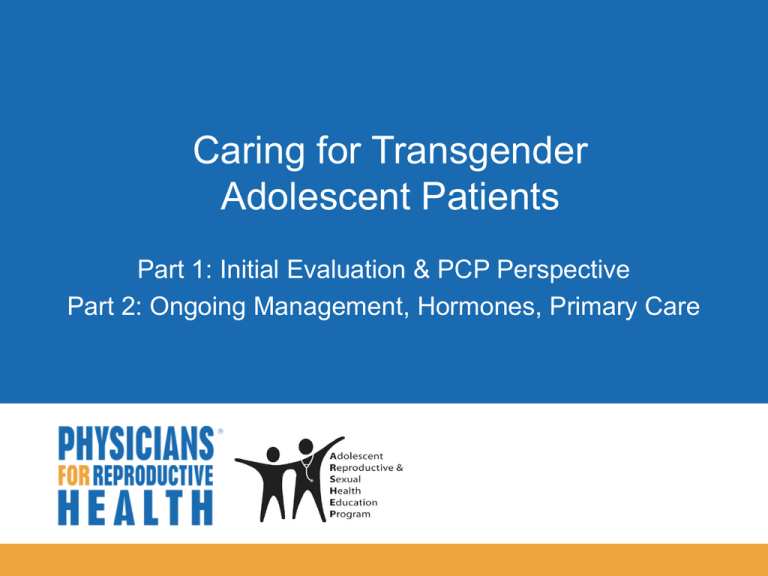
Caring for Transgender
Adolescent Patients
Part 1: Initial Evaluation & PCP Perspective
Part 2: Ongoing Management, Hormones, Primary Care
Objectives
Differentiate natal sex, gender identity, gender
expression & sexual orientation
Explain how bias & victimization create disparities
and lead to risks
Discuss primary and specialized care that may be
needed by transgender adolescents
Provide initial management strategies for appropriate
& competent care to gender non conforming patients
2014
Early Childhood & Prepubescent
Gender Development
Case 1 Patient “R” Pre-pubertal Gender Nonconformity
R is an 8 y/o natal male
During the visit, R’s parent
expresses concern that
“Most of his friends are
female.”
“He hates sports.”
“I caught him wearing his older
sister’s clothes and make-up
last week.”
“He loves to paint his nails.”
2014
Case 1 Patient “ R “
What is your initial reaction?
Are you concerned?
Should his parent be concerned?
2014
Gender and Sexuality Spectrum & Fluidity
XY
Biological Gender
Male
XX
Intersex
Female
Gender
Identity & Expression
Masculine
Androgynous
Feminine
Sexuality
Attraction, Orientation, Behaviors
Gynophilic
Androphilic
2014
Gender
Expression
Gender …
Who we are
Natal or biologic gender – Brain, hormones, body parts assigning male female
gender, usually at birth
Gender identity - Person’s basic sense of being male or female, especially as
experienced in self-awareness and behavior
Gender expression -Ways in which person acts, presents self & communicates
gender within a given culture
Sexuality…
Who we love
LGBTQQI … Lesbian, Gay, Bisexual, Transgender, Queer,
Questioning, Intersex
YMSM– Young Men who have Sex with Men
YWSW- Young Women who have sex with Women
Pansexual, asexual
Why Talk about Gender?
Professional responsibility
AMA, AAMC, AAFP, AAP, SAHM, APA
Recommend training on LGBT health
Gender care is
Patient-centered primary care
Gender is developmental, universal
Anticipatory guidance
Prevention
Future planning
2014
Case 1
Patient “ R “
You ask R’s mother if you can
speak to R in private to ask
How he views his gender
Does he feel more like a boy
or girl?
Does he have a preferred
name?
How could his parents help?
How does he feel about
parents’ concerns
2014
Awareness of
Gender Identity
Between ages 1 and 2
—Conscious of physical differences
between sexes
At 3 years old
—Can label themselves as girl or boy
By age 4
—Gender identity stable
—Recognize gender constant
2014
Gender Play
All pre-pubertal children play with gender
expression & roles
▫ Passing interest or trying out gender-typical
behaviors
▫ Interests related to other/opposite sex
▫ Few days, weeks, months, years
Gender Nonconforming Youth
Persistent, consistent, insistent
Cross gender expression, role playing
Wanting other gender body/parts
Not liking one’s gender & body (gender
dysphoria)
“She told me in first grade that she was a boy.”
“He wanted to grow his hair long and wear jewelry.”
“She adamantly refused to wear a dress to her aunt’s
wedding.”
“He wanted to be in the school play in the role of
Cinderella.”
2014
Who to Screen?
All children
Developmental stages
Non-conforming expression
Concerns/problems with
Mood
Behavior
Social
2014
How to Screen
Ask!
Parent(s)
Ask!
Patient
Child play, hair, dress
preferences
Do you feel more like a girl,
boy, neither, both?
Parent concerns with these
How would you like to play,
cut your hair, dress?
Concerns re behavior,
friends, getting along at
school, school failure,
bullying, anger, sadness,
isolation, other???
What name or pronoun (he
for boy, she for girl) fits you?
2014
Kid Friendly Gender Screening
2014
Case 1
Patient “ R “
R reports
Sometimes wishes he was a girl but prefers the
pronoun “he”
Sadness that his mother is upset
Unsure what gender he would be if he could
choose
He would like to play with girl things without
feeling bad
What do you do next?
2014
Case 1
Patient “ R “
Explain to R & his mom that
Exploring gender roles & gender expression
during childhood is common
R may or may not have gender identity concerns
as he matures
Support from family is essential
Offer yourself as a resource
Know national, local resources
2014
Development Issues
Pre-pubertal Gender Nonconformity
Epidemiology depends on definition, populations, survey or
instrument, culture
Gender variant 1:500
Transitioned 1:20,000
Prepubertal developmental considerations
Many children 5-12 years with gender dysphoria do not
continue to suffer as adolescents
Some identify as homosexual or bisexual
• Natal males – 63% to 100%
• Natal females – 32% to 50%
2014
Pathologic vs. Developmental
Perspective
DIAGNOSIS of GENDER DYSPHORIA
Marked difference between expressed/experienced gender and
gender others would assign
Must continue for at least six months
Causes clinically significant distress or impairment in social,
occupational, other important areas of function
Children the desire to be of the other gender must be present
and verbalized
Patient center developmental care
Allows flexibility, clinical judgment
2014
Why Identify & Support Early?
Support Matters!
Family Acceptance Project Data
224 LGB white & Latino adults, ages 21 to 25 years
Open sexual orientation to at least 1 parent during adolescence
“Between ages 13–19, how often did your parents/caregivers…”
Association parental rejecting behaviors & negative
health outcomes
OR
Negative Health Outcomes
3.4
Unprotected sex
5.9
Depression
5.6
Suicidality
8.4
Suicide attempt
I love you
Accept you if not understand
Protective… Resilience
Addressing Parents’ Questions
Behaviors & expression may non-conform,
but children can still feel that they are in right-gendered body
Family acceptance, love, support critical
All children are at risk for crisis when their true sense of identity is
discouraged &/or punished
2014
Adolescents & Gender
Case 2
Patient “K”
K is a 12 yro natal female brought
in by her mother for mood &
behavior concerns
As you explore these concerns,
you learn
K identifies as male & gender
expression is very masculine
K is distressed by onset of
puberty & not sure what to do
next
2014
Terminology: What’s in a Name?
Transgender = umbrella term for individuals & communities
A person whose identity does not conform unambiguously to
conventional notions of male or female gender roles, but blends or
moves between them
Gender nonconforming = individuals who do not follow other
people’s ideas or stereotypes about how they should look or act
based on the female or male sex they were assigned at birth
Cisgender = a person whose gender identity conforms
unambiguously to conventional notions of gender, and matches their
natal/biologic gender
2014
Transgender Umbrella
Drag queen/king
Cross-dresser
Bi-gendered
Pre/post-operative
Gender bender
Intersex
Two-spirit
Femme queen
Stud
Femme boi or
Gender queer
Femme boy
2014
Identities and Transition
Identities include but are not limited to:
MTF=male to female,
transgender woman
FTM=female to male,
transgender man
Transition
Process and time when person goes from living as one
gender to living as another one
2014
Case 2
Patient “K”
13 yro natal female with male
gender identify & expression,
distressed by onset of puberty
K is interested in not having
periods, looking as male as he
can & has done some preliminary
investigation of transgender
What do you do next?
2014
Setting Up the Initial Assessment
Establish privacy
Ask mom to step out of room
Explain what can (& can’t) be kept confidential
Establish trust & rapport
Ask name & preferred pronoun
Ask goals of visit
Getting to know the person
General adolescent health assessment
HEADDSSS
Leading into more detailed & sensitive history
2014
What Not to Do
Interview only with parent in room
All teens deserve private time
Assume
Name or pronoun
Gender identity & expression correlate
Disclose without patient’s consent
Dismiss
Parents as a source of support
As a phase
Refer for reparative therapy
2014
Strength & Risk Assessment
Assess personal strengths, resources, goals
Assess social support & resources
Address risk taking or safety concerns
Mental health—depression, anxiety, self harm,
suicide
Substance use/abuse
Sexual activity—STI & pregnancy prevention
2014
Gender Experience
Review history of gender experience
Open ended encouragement “Tell me your story in
your own words”
Ask about specific feelings, thoughts, behaviors,
preferences
Parent may offer excellent insight into early
childhood
Document prior efforts to adopt desired gender
Clothing, make up, play
Hormone use if any
Review patient goals
2014
Case 2
Patient “K”
Engage parent(s) to support their child
Explore parent’s concerns & priorities
Assess parental support & knowledge
Facilitate discussion & negotiations
Establish expectations for all stakeholders
Incorporate patient goals, with parent
expectations, & management options
2014
Remind Youth, Parents… What is Healthy?
Gender & sexual development are
natural parts of human development
Gender & sexual expression vary
Gender & sexual diversity are different than risk
Open, honest communication is critical to healthy decision
making, behaviors, support, & access to care
Case 2
Patient “K”
Mental health provider
• Assess/treat other mental health concerns
Medical provider
• Assess & consent for hormonal management
Consider appropriate referrals to providers with
experience in transgender care
• Assess gender nonconformity
• Assess readiness for transition
2014
Referrals & Seeking Specialized Care
Many mental health & medical providers will
not have expertise in transgender health
Transgender health “specialists”
Variety of providers with experience &/or training
in caring for transgender patients
Wide variety of disciplines, degrees, specialties
YET!
We have
lots of work
to do
2014
Case 2
Patient “K”
Medical & mental providers confirm
Gender identity & gender needs
Gender dysphoria
Benefit from delaying puberty or hormones
K’s mother is supportive
Are these recommendations in-line with national
consensus and/or guidelines?
2014
Treatment Goals
Improve quality of life by
Facilitating transition to physical state that more closely
represents the individual’s sense of self
Experience puberty congruent with gender
Prevent unwanted secondary sex characteristics
Reduce need for future medical , surgical interventions
Avoid depression, risk taking
Establish early, strong social support
2014
Views on Treatment of Gender Dysphoria
in Adolescents
No treatment until 18
Full pubertal experience
Allow some experience of puberty
•
Until age 15–16 or Tanner 4
•
Then start GnRH analogues or hormones
Gender identity stable, gender dysphoria DSM
criteria met
•
Start GnRH analogues Tanner 2 (age 12–13)
•
Initiate hormones several years later
2014
Phases of Transitioning
Reversible
• clothes, hair, shoes, toys,
GnRH analogues
Partially
reversible
• masculizing & feminizing
hormone therapy
Irreversible
• gender reassignment
surgery (GRS)
2014
Benefits of
Early Treatment
If transgender identified pre/early puberty
consider “blocking” puberty
Effects fully reversible
“Buys time” & avoid reactive depression
Psychotherapy facilitated when distress eased
Prevent unwanted secondary sex characteristics
• Reduces needs for future medical interventions
2014
Beginning Hormonal Treatment
Assess readiness for transition
Physical (Tanner stage)
Psychological
Social
Review risks & benefits of hormone therapy
Differentiate between reversible & irreversible
physical changes
Establish next steps for “real life” experience
2014
Planning for Hormonal Treatment
Prescribing provider will establish
Informed consent
Reasonable goals, expectations
Baseline screening labs
Set up referrals &/or follow up
Provider & patient should establish
Disclosure when patient is ready
Sources of social support
Impact on school or work
2014
Case 3
Patient “B”
B is 16 y/o MTF kicked out
by her mother’s boyfriend for
being “gay”
B presents as female
B’s is new to you & present
with chief complaint of
“genital rash”
What next?
2014
Case 3
Patient “B”
Establish safety, trust, rapport
Evaluate problem patient wants help with
If time…begin HEEADDSSS assessment knowing health risks
for transgender population
HEADDSSS screen reveals
Victimization at home & school
Sex work with consistent unprotected anal (receptive) & oral sex
Depression, considered suicide in past
Substance use, meth & alcohol
Street hormones & silicone injection
Last HIV test one year ago
2014
Sexual Health History
What are gender(s) of
your partner(s)?
Have you ever had
anal, genital, or oral
sex?
Do you give, receive,
or both?
How many partners
have you had in past
six months?
Do you use condoms
…. never, some,
most, all of the time?
Any symptoms of
STIs….
2014
Risk Behaviors
MTF Youth
Anal sex (no condom)
UAI (receptive)
Sex for money/shelter
Sex & drugs
Coerced sex
HIV
AA youth
59%
49%
59%
53%
52%
22%
RR ↑ 8x
Homeless
18%
Incarceration history
37%
2014
Risk Behaviors
MTF Youth
151 MTF youth LA & Chicago
Ever sex work
70%
Ever HIV tested
of 19% (24) HIV+ few in care
85%
Ever homeless
43%
Ever incarcerated
52%
Street Drugs
52%
Poverty (<$1000/month)
70%
2014
Case 3
Patient “B”
Given B's sexual &
drug history
HIV serology
Syphilis serology
NAAT urine GC/CT
Rectal GC /CT
Pharyngeal GC
Hepatitis C
What immunizations?
• Hepatitis A & B
• HPV
2014
Minority Stress Theory
Stigma
Gender or
Sexual minority
Prejudice, Discrimination, Abuse
Lack of Acceptance
Isolation, Esteem, Resources
Suicide
Substance use
SES disadvantage
Victimization
Anxiety
Depression
Minority Stress
2014
Harm Reduction Counseling
Safer sex options
Facilitate condom use
Plan for STI testing
Support & survival
Housing/shelter/food referral
Vocational assistance
Substance abuse screen/counseling
Mental health screen/counseling
Close follow-up
2014
Trans Survival… Barriers to Care
Loss of parental & familial support
Loss of housing, emotional & financial care
Lack of health care
Loss of insurance/ability to pay
Access, availability of health providers
Concerns re confidentiality, rights to care
Social stigma
Hostile or violent social environments
Mental health sequelae
2014
Create a Trans-Friendly Environment
Visible non-discrimination policy
Staff training, openness
Use preferred pronoun & name
Transgender inclusive materials
Unisex/Individual bathrooms
Respect confidentiality, don’t “out”
2014
Transgender Youth
Take Home Points
Children & youth explore gender as well as
sexual identity
Provider role
Assessing individual goals, needs, risks
Facilitating communication, support of family
Referrals for support & resources
Creating safe space for all youth
2014
Caring for Transgender
Adolescents
Part 2: Understanding Medical Management &
Providing Ongoing Primary Care
Case 2
Patient “K”
K is a13 yro natal female identifying as
male with some male gender expression
Currently uses given name in most
social situations
Would like to use pronoun “he” &
male name
K, his parents, other members of his
health care “team” agree
He is experiencing GID
His gender identity as male is stable
He would like to transition to male
2014
Beginning Hormonal Treatment
Establish commitment to next steps
Gender incongruency
Readiness for transition
Expectations, goals
Management plan
Obtain informed consent
Order baseline labs
Establish follow up
Letter from
mental health
professional?
2014
Phases of Transitioning
Reversible
• clothes, hair, shoes, toys,
GnRH analogues
Partially
reversible
• masculizing & feminizing
hormone therapy
Irreversible
• gender reassignment
surgery (GRS)
2014
Benefits of “Blockers”
Gonadotropin Releasing Hormone (GnRH)
analogues block puberty
Leuprolide
Histrelin
Delay irreversible 2
ndary
sex characteristics
Allow time for teen to mature & make decision
Allow time for parent & social support to develop
Allow provider reluctance for irreversible effects in
minor
2014
Risks of “Blockers”
Bone mineral density reduced
Reversible once hormones initiated
Shots hurt
Height reduction (MTF) if started
early
Going
to the doctor
Not necessarily bad thing
for MTF
takes
Negligible impact on height
for time
FTMs& effort
Lack of 2
peers
Expense
ndary
sex characteristics compared to
Relief>>> Risk or
Harms
2014
GnRH Analogues
Continuous GnRH secretion
Suppress FSH, LH
Initial ↑ LH, FSH followed by desensitized pituitary
LH FSH secretion suppressed
Leuprorelin, Triptorelin, & Goserelin
Monthly & 3-monthly depot preparations
Histrelin implant
12 month
Typically not covered by insurance
2014
Dosing GnRH Analogues
Select dosing schedule
Monthly depot SQ or IM
• Range 3.75, 7.5, 11.5 mg
3-monthly long-acting 11.25 mg IM
Counseling & Consent
• Few side effects aside from injection pain,
withdrawal bleed if menarchal
• Expect to see some “ effects” in 2-4 week range
2014
Phases of Transitioning
Reversible
• clothes, hair, shoes, toys,
GnRH analogues
Partially
reversible
• masculizing & feminizing
hormone therapy
Irreversible
• gender confirmation/affirmation
surgery (GCS/GAS)
2014
Case 3
Patient “B”
Homeless16 y/o MTF returns
Presents as female
Trades sex for drugs & shelter
Diagnosed genital HPV last visit
Follow visit plan
To learn more about how you can
medically support her transition
2014
Early Access to
Cross-Gender Hormones
Increased opportunities for preventive health care
Improved family functions, school performance
Child development in identified gender
Prevents risk taking, suffering
Leads to social change
Goals… improve quality of life
2014
Feminizing Hormones
Estrogens - induce development female
ndary
2
sexual characteristics
Anti-androgen treatment reduce effect of
endogenous male sex hormones
Spironolactone
Use if no contraindications (renal disease, ↑ K)
Progestins for breast tissue development?
2014
Estrogen
Estradiol
Sublingual 2–8 mg/day total dose
• Decreased risk TE preferred over oral daily
• $4 at Walmart
Patch 0.1–0.4 mg twice weekly
Estradiol cypionate or valerate injection
5–20 mg IM q 2 wks
2014
Other Feminizing Options
Anti-androgens
Spironolactone 50–100 mg PO BID
Finasteride 2–5 mg PO QD
Progesterone
Medroxyprogesterone (Provera) 5-10 mg PO QD
Linked to weight gain, tubular breasts
Unclear if benefit
Cosmetics
Hydroquinone, vaniqua, laser, electrolysis
2014
Effects of Feminizing Hormones
Varies from patient to patient
Noticeable changes within 4 weeks
Irreversible effects prior to 6 months
Effects continue at decreasing rate for < 2
years
Post ochiectomy “spurt” of breast growth &
feminization
Decrease estrogen dose needed
2014
Predicting Effects of Feminizing
Hormones
Action
Onset
Max
↓ libido, ↓ erections
↓testicular volume
May ↓ sperm production
Breast growth
Body fat redistribution
↓ muscle mass
Softens skin
↓ terminal hair
No change in voice
1–3 mo
25% 1 yr
?
3–6 mo
3–6 mo
1 yr
3–6 mo
6–12 mo
3–6 mo
50% 2–3 yr
?
2–3 yr
2–3 yr
1–2 yr
?
> 3 yr
2014
Risks of Feminizing Hormones
Complete risks are unknown
Most studies performed in biological
women
Limited research regarding risks
Mortality not necessarily increased
FDA all administration off-label
More research in the pipeline
2014
Risks of Feminizing Hormones
VTE
Increased Weight
Decreased Libido
Erectile dysfunction
Liver dysfunction
TG ↑ (pancreatitis)
HDL ↑ LDL ↓
Increased BP
Glucose intolerance
Gall bladder disease
Pituitary adenoma
Breast cancer (3
cases)
Anti-androgens
↑K
↓ BP
2014
Case 3
Patient “B”
Since the last visit, B reports
More consistent use of condoms with new
partners after your last visit
Taking estrogen, purchased over Internet
She would like stronger dose from you as she
wants more feminizing effects & breast
changes
2014
Issues with Self-Prescribed
Hormonal Therapy
Excessive amounts
Increased risks & medication side effects
Does not increase feminization nor override heredity
Excess estrogen can be converted to testosterone
Quality
Purity not guaranteed
Medication & dose not garanteed
Safety
Self-injection poses HIV & hepatitis risks
2014
Baseline Labs
Feminizing Hormone Therapy
CBC
LFTs
Lipids
Chem 10
Estrogen
Testosterone
Prolactin
If before or using
estradiol
•AST
•Prolactin
•? T or E
If spironolactone
•Potassium
2014
Lab Follow-Up
for Feminizing Hormone Therapy
Q 3 months 1-2 years
Test according to need
Testosterone level at 1 yr
Goal
< 55 ng/dl
Estradiol
If concerns re overuse
Goal ‘average female levels”
K (Cr)
If spironolactone
Goals
Dosing & labs by
Generate desired
effects
Avoid side effects
Average natal levels
2014
Long Term
Procedural Options for MTFs
Breast implants
Orchiectomy/penectomy
Vaginoplasty
Facial feminizing
Vocal cord surgery
Plastic surgery (waist, hip, buttocks)
Rib removal (11–12)
2014
Health Care Maintenance for MTFs
Emotional well-being
Breast cancer screening
STI testing, prevention
Self breast exam
Fertility considerations
Mammography 10+
years or age 50
Sperm/embryo
banking
Contraception
Additional screenings,
limited evidence
?Prostate screening
for older patients
?Pap is neo cervix
created
2014
Case 4
Patient “C”
C is 21 y/o FTM reporting
Self injects testosterone
from Internet for two years
Has just relocated to start
new job
Wants to establish his
identity as male at work
2014
Testosterone
Multiple dosing regimens
Oil based testosterone for injection
Cypionate or enanthate
3cc lauer lock syringe, 18 guage needle to withdraw
SQ 50–100 mg SQ weekly 5/8th inch 25 guage needle
• Decreased peaks/troughs, side effects
IM 50-100 mg weekly or 100-200 mg 1-1.5 inc 22
guage every other week
2014
Masculinizing Hormones
Other formz
Transdermal androderm 2.5–10 mg daily
Androgel 2.5–5 mg packets with dosing
50–100 mg daily
Topical testosterone to clitoris will not
increase size
Progestins may be used short term to stop
menses
2014
Predicting Effects of Masculinizing
Hormones
Action
Male pattern facial/body hair
Acne
Voice deepening
Clitoromegaly
Vaginal atrophy
Amenorrhea
Emotional changes/ ↑ libido
Increased muscle mass
Fat distribution
Tendon weakening
Onset
6–12 mo
1–6 mo
1–3 mo
3–6 mo
2–6 mo
2–6 mo
Max
4–5 yrs
1–2 yrs
1–2 yrs
1–2 yrs
1–2 yrs
6–12 mo
1–6 mo
2–5 yrs
2–5 yrs
2014
Risks of Masculinizing Hormones
Weight increase
Mood changes
Liver dysfunction
TG ↑ HDL ↓ LDL ↑
Insulin resistance
Increased homocysteine
Polycythemia
Male pattern baldness
Possible pelvic pain
2014
Management of Side Effects of
Masculinizing Hormones
Rogaine to treat pattern baldness
Estrogen vaginal cream for atrophy
Retinoids for acne
Progestin for menses
Spotting may occur for several months
followed by amenorrhea
2014
Initial Lab Testing for
Masculinizing Hormone Therapy
CBC
LFTs
Lipids
Cr, Glucose
Testosterone
If using T
•AST
•Hb
•Testosterone total
•Lipids
2014
Lab Follow-Up
for Masculinizing Hormone Therapy
Q 3 months 1-2 years
Test according to need
Goals
Dosing & labs by
Testosterone level at 1 yr
Goal 300-750 ng/dl
Generate desired
effects
CBC
Liver function tests
Lipids
Avoid side effects
Average natal levels
2014
Case 4
Patient “C”
C had chest reconstruction
surgery two years ago
He is considering completing his
transitioning with a
hysterectomy& oopherectomy
next year or two
What might be some problems
inherent with obtaining GCS?
2014
GCS for FTMs
Male chest construction
Different technique than mascectomy or implants
Hysteroopherectomy
Phalloplasty /metoidioplasty
No function without pump
Rarely covered by health insurance
Performed by specialized surgeons
2014
Case 4
Patient “C”
During your sexual history, C reports
He is in relationship with another male & identifies
as a gay man having insertive sex in both genital
openings (anal/vaginal)
Last STI screening 3 years ago when C had
parents’ insurance
C has never had a Pap test & expresses anxiety
over having “a Pap”
How can you help? Does he need a pelvic exam?
What about a Pap? STI testing?
2014
Assure
That he is not alone and many patients
are uncomfortable with pelvic exam
Provide
Information on why exam is necessary
Use
Preferred pronouns & terms for anatomy
Discuss
Steps of the exam before & during
Support
Making positive decisions about
reproductive & sexual health
Maintain
Best practices for both anatomy &
hormones
Health Care Maintenance for FTMs
Emotional well being
STI testing
Including HIV
PCOS
Glucose testing
Fertility
Contraception
Breast cancer screening
Instructions in self breast
exam
Mammography
Pap cancer screening
Atrophy looks like dysplasia
? Dexa scans
Testosterone > 5 yrs
Age > 50
2014
STI Screening
CDC guidelines according to anatomy &
behaviors
Female anatomy < 25 y/o yearly NAAT
screen for GC & Chlamydia
Vaginal & anal sex with MSM screen for
syphilis & HIV
2014
Contraception
FTM may have some pregnancy risk
Testosterone not fail-safe contraceptive
May continue to ovulate while on testosterone
Testosterone may adversely affect development of
fetus
Consider DMPA, Mirena, & barrier methods
Avoid assumption do Family Planning
Do you want to be pregnant or have genetic children?
2014
Transgender Youth
Take Home Points
Screening for gender issues, like sexual health
concerns, important throughout life span
Medical management of treatment, including hormones,
safer than self prescribing
Mental health & support important
STI & other health care maintenance continue
Recognize vocational, financial, & social discrimination
2014
What Health Care Providers Can Do…
What
Can
Family
Physicians
Do?
Infrastructure
Make office, clinic, wait areas gender neutral
Work with clinic staff to create trans friendly
Screen patients of all ages
Training
environment
Practice and administrative
changes
Zero tolerance policies
Offer primary care and referrals
Allhealth
patients,services
at various points of development and age
Integrating transgender
Screen
All children with mood, behavior, & school problems
Teach students, residents and colleagues
Identify
Become comfortable take a more detailed gender
history
Offer primary care
Promote open disclosure & acceptance
Offer referrals & resources
Offer gender care and/or referral to gender experts
Advocacy
Promote diversity in your professional & personal
communities
Please Complete Your
Evaluations Now
2014
Specialized Health Services
Hasbro Children’s Hospital (Providence)
www.hasbrochildrenshospital.org
Children’s Hospital Los Angeles www.transyouthLA.org
BC Childrens Hospital (Vancouver) www.bchildrens.ca
Howard Brown Health Center (Chicago)
www.howardbrown.org
Mazzoni Center (Philadelphia) mazzonicenter.org
Whitman Walker Clinic (Washington, DC) www.wwc.org
Fenway Institute (Boston) http://www.fenwayhealth.org
Callen-Lorde Community Health Center (New York)
www.callen-lorde.org
2014
Provider Resources
Transgender Health
Center of Excellence for Transgender Health
http://transhealth.ucsf.edu
Gay and Lesbian Medical Association www.glma.org
World Professional Association for Transgender
Health www.wpath.org/index.cfm
National Center for Transgender Equality
http://www.transequality.org/
Transgender Law Center
www.transgenderlawcenter.org
2014
Additional Provider Resources
www.prh.org—Physicians for Reproductive Health
www.aap.org—The American Academy of Pediatrics
www.acog.org—The American College of Obstetricians and
Gynecologists
www.adolescenthealth.org—The Society for Adolescent Health and
Medicine
http://www.aclu.org/reproductiverights—The Reproductive Freedom
Project of the American Civil Liberties Union
www.advocatesforyouth.org—Advocates for Youth
www.guttmacher.org—Guttmacher Institute
www.cahl.org—Center for Adolescent Health and the Law
www.gynob.emory.edu/centers/jfc—The Jane Fonda Center of Emory
University
www.siecus.org—The Sexuality Information and Education Council of
the United States
www.arhp.org—The Association of Reproductive Health Professionals
www.rhtp.org—Reproductive Health Technologies Project
2014

